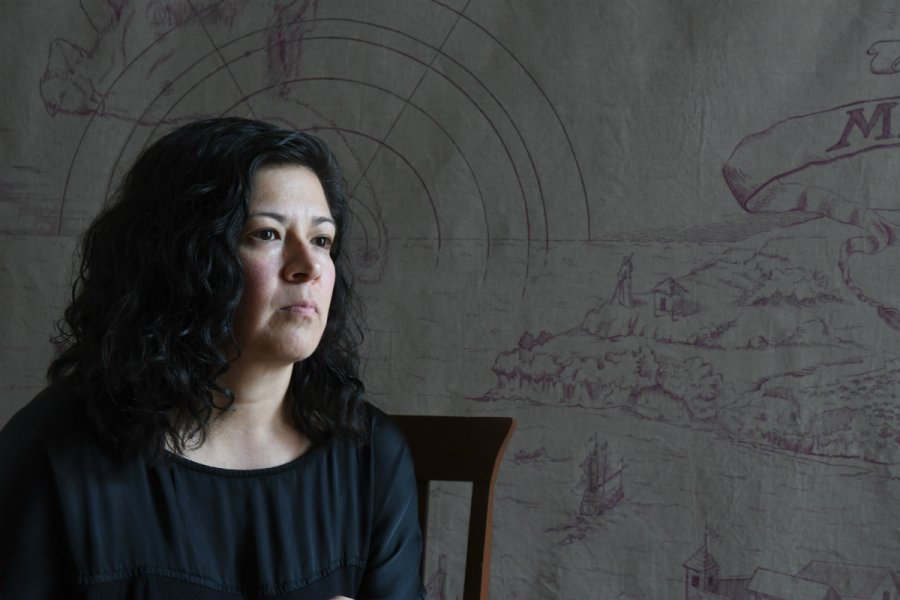Noticias
Visual Artist Dulce Chacón to represent Mexico at the Manila Biennial 2018
February 15, 2018Starting from the close relationship between Mexico and the Philippines during the viceroyalty period, the current member of the National System of Art Creators of the Fonca (National Fund for Culture and Arts) expresses in two large format canvases emblematic events of two ports, Acapulco and Manila.
The Manila Galleon was the name given to the Spanish ships crossing the Pacific Ocean once or twice a year between Manila and the ports of the former New Spain.
The commercial routes included the Manila-Acapulco-Manila line, one of the longest in history that ran for two and a half centuries until Mexico's Independence in 1810.
With a creative production oriented to drawing, Dulce Chacón emphasized that to carry out this piece she took the risk of exploring new materials, textures and even dimensions.
“I mainly draw on paper, but taking into account the weather conditions, humidity and high temperatures in Manila, I chose to try the linen fabric because it is very resistant and I used the "rabbit tail" technique to help absorb the ink and seal it to the fabric”.
For a month and a half, two canvases measuring 1.38 x 4.88 meters each were the basis on which the artist used carmine cochineal ink to draw different images taken from old documents, illustrations, naval charts, letters to the Crown and maps.
“My work starts from photographs or images already existing to make the compositions. I thought it was appropriate to use carmine cochineal because along with the silver, it was one of the two products that were transported from Acapulco to Manila, so it was interesting to talk about the materials that travelled from here to there”.
The first canvas begins from Acapulco to the walled city of Manila. The sun, the constellation of the Ursa Minor and the polar star that guides the sailors stand out, as well as boats from the time of the Viceroyalty.
The second canvas starts from Manila to Acapulco and develops a contemporary history of the two ports where the cultural and commercial close relationship has already been broken and each one had its own history.
According to Dulce Chacon, these are scenes that focus on the bombing of Manila near the end of World War II because of a battle between the U. S., Philippine and Japanese forces in 1945.
“I also take up the figure of the phoenix to show that after that Manila will be reborn, while on the side of Acapulco is shown that idyllic planning of tourist place, beautiful par excellence, but today is crushed by the shadow of violence”.
The work Vánitas Portus, in which the water has an important presence, will be placed in a circular shape inside the bastion of San Diego with the intention that visitors will admire the view of the two ports.
Regarding the title, the creator pointed out that it refers to the pictorial genre that alludes to the moments of transition of the human being that are inherent to life.
“It refers to the transmutation that has life, soul, spirit, knowledge and how there is a change in a historical moment of exploration”, said Chacón, who has exhibited in venues such as Ex-Teresa Arte Actual, Museo de Arte Carrillo Gil, Casa del Lago, Centro Cultural de España and Museo de Arte Moderno; and abroad, in countries such as Spain, Holland, Portugal, Czech Republic, the United States, Uruguay, Colombia and Argentina.
Concerning the technique, the visual artist said that in recent years the drawing has been more independent to demonstrate that it is not only a tool used for sketching or preparing works.
“I see many possibilities, it can be a thousand things at once because it corresponds to the ideas and discourses of many other disciplines and has its own language that can be independent of all others. Thanks to this new way of looking at drawing, today it is a discipline with a lot of potential”, said the graduate of Visual Arts at the then National School of Plastic Arts.
“One of the things I like about drawing is that it's direct and honest. If you make a mistake, you have two options: you follow it or destroy it and start a new one, but in my case I like mistakes to help me see how much that same technique gives”.
Mexico,Distrito Federal
